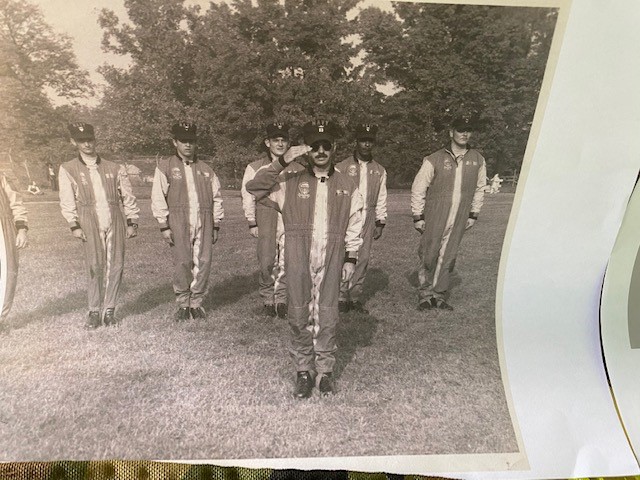VIRGINIA BEACH, Va. (WAVY) – At 77 years old, former Navy Frogman Eddie Ferguson is still something of a daredevil. If he’s not riding around Virginia Beach, Virginia on two mean wheels, he’s riding on a motorized unicycle.

Filmmaker Andre L. Ferguson is his son.
“He’s earned his time. He’s done his duty for the country and he has earned his time to relax and have fun and have the toys he’s always wanted. I think it’s a great thing; I just want him to be careful,” said Andre.

The long trip started in 1961 when a 17-year-old from Fort Myers, Florida, inspired by a relative, decided to join the Navy.
“My only inspiration for joining the Navy was my uncle,” said Ferguson.
It didn’t matter that cook or steward was the only job for Uncle Leonard Moody back in the 1950s. Eddie wanted to sign up as the Cold War was underway and U.S. advisers were already in Vietnam.
Onboard the USS Okinawa he met a recruiter from the Underwater Demolition Team and the newly minted SEAL team. The recruiter showed a video to Ferguson, who was the only Sailor who bothered to show up for the presentation.

“At the conclusion of the video, I was asked if I wanted to take the screening test. I said yes. I submitted my special request chit (form) to the department head and I would have to go to Little Creek, Virginia to take the screening test,” said Ferguson.
“It required swimming, first of all, a 300-yard swim in 7 minutes and 30 seconds. So I got busy and I would only use two strokes. My hands and feet could not break the surface of the water so I would have to do a sidestroke or a breaststroke. It was a learning curve to complete this screening because I had never taken a swimming lesson in my life.”
“When the timer said time, it was seven minutes and 29 seconds, but I finished.”
That swim was followed by a one-mile run and calisthenics in boots.
In Basic Underwater Demolition/SEAL (BUDS) training, which also took place at Little Creek, he nearly drowned twice during a so-called drown-proof test.
“They jumped in the water and pulled me to the side again. Now in BUDS, if you do not touch the wall, you fail and you are out [of the program], but during those days I guess they figured I wanted it that bad.”
In 1965 Ferguson was pinned with the trident but he was still in Jim Crow’s South.

“It was kinda like a Jackie Robinson effect we had to withstand in the teams. I wouldn’t say a lot, but some racist comments, n-word said, that type of thing. I was told don’t go on your own on Church Street [in Norfolk, Virginia], so sailors would go on Church Street at night and we would wear our uniforms with the trident and everything on Church Street and we were told by the white frogs and SEALs not to go out and brag about what we had accomplished, as though Black people could do the same as they did.”

Following BUDS, Ferguson had to make a decision.
“I chose to go to UDT rather than SEAL team; SEAL teams are the ones who went to Vietnam duty; we still had to make deployments to the Mediterranean, Caribbean, and Norway.”

“There was some secret stuff going on in those days. It’s been declassified now, but I still hesitate to talk about it. It involved nuclear weapons.”
Ferguson will not discuss missions of the past, but he will talk about two incidents that could have been fatal. Once, his primary parachute failed, and his swim buddy saved his life while training in waters off Little Creek, Virginia.
“I got a little bit behind the power curve in my breathing; it was no way I was getting enough oxygen.
They detected that and brought me to the surface and took my mask off in order to get fresh air.”
Chief Eddie Ferguson retired from the Navy in 1982 at E-7. He spent another 20 years in civil service. The years have been good to Ferguson and other men – Bill Goins, and Lamont King – who plied waters that were uncharted for a Black man in the 60s.
The son who grew up watching his father perform in air shows is producing a documentary titled 33 Black Frog: The life story of Chief Petty Officer Eddie Ferguson.

“In the documentary, we had a discussion about having to deal with the racial situations among the ship and we found that joining the Navy SEALs UDT was a way to get away and get with a group of folks that cared about each other and knew each other’s life depended on each other.”
The younger Ferguson hopes his documentary will inspire the next generation of Black frogmen.
“I think that in his case he had to sort through de-escalating and try to get through the difficult situations he had to go through in being a frogman just so that he could get through to pave the way for others to get through,” said Andre Ferguson.
33 Black Frog is set for release in July of 2022.

























